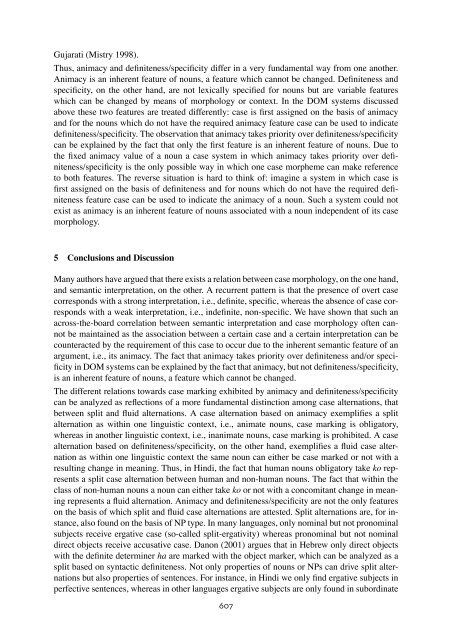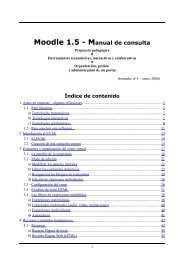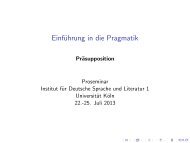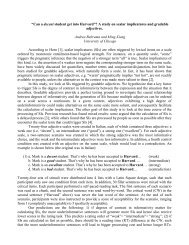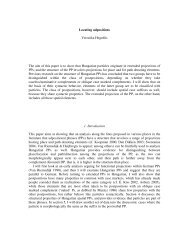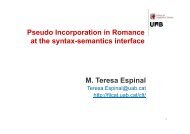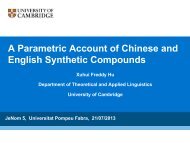Semantic aspects of differential object marking - corpora@parles.upf ...
Semantic aspects of differential object marking - corpora@parles.upf ...
Semantic aspects of differential object marking - corpora@parles.upf ...
Create successful ePaper yourself
Turn your PDF publications into a flip-book with our unique Google optimized e-Paper software.
10 Peter de Swart and Helen de Hoop<br />
Gujarati (Mistry 1998).<br />
Thus, animacy and definiteness/specificity differ in a very fundamental way from one another.<br />
Animacy is an inherent feature <strong>of</strong> nouns, a feature which cannot be changed. Definiteness and<br />
specificity, on the other hand, are not lexically specified for nouns but are variable features<br />
which can be changed by means <strong>of</strong> morphology or context. In the DOM systems discussed<br />
above these two features are treated differently: case is first assigned on the basis <strong>of</strong> animacy<br />
and for the nouns which do not have the required animacy feature case can be used to indicate<br />
definiteness/specificity. The observation that animacy takes priority over definiteness/specificity<br />
can be explained by the fact that only the first feature is an inherent feature <strong>of</strong> nouns. Due to<br />
the fixed animacy value <strong>of</strong> a noun a case system in which animacy takes priority over definiteness/specificity<br />
is the only possible way in which one case morpheme can make reference<br />
to both features. The reverse situation is hard to think <strong>of</strong>: imagine a system in which case is<br />
first assigned on the basis <strong>of</strong> definiteness and for nouns which do not have the required definiteness<br />
feature case can be used to indicate the animacy <strong>of</strong> a noun. Such a system could not<br />
exist as animacy is an inherent feature <strong>of</strong> nouns associated with a noun independent <strong>of</strong> its case<br />
morphology.<br />
5 Conclusions and Discussion<br />
Many authors have argued that there exists a relation between case morphology, on the one hand,<br />
and semantic interpretation, on the other. A recurrent pattern is that the presence <strong>of</strong> overt case<br />
corresponds with a strong interpretation, i.e., definite, specific, whereas the absence <strong>of</strong> case corresponds<br />
with a weak interpretation, i.e., indefinite, non-specific. We have shown that such an<br />
across-the-board correlation between semantic interpretation and case morphology <strong>of</strong>ten cannot<br />
be maintained as the association between a certain case and a certain interpretation can be<br />
counteracted by the requirement <strong>of</strong> this case to occur due to the inherent semantic feature <strong>of</strong> an<br />
argument, i.e., its animacy. The fact that animacy takes priority over definiteness and/or specificity<br />
in DOM systems can be explained by the fact that animacy, but not definiteness/specificity,<br />
is an inherent feature <strong>of</strong> nouns, a feature which cannot be changed.<br />
The different relations towards case <strong>marking</strong> exhibited by animacy and definiteness/specificity<br />
can be analyzed as reflections <strong>of</strong> a more fundamental distinction among case alternations, that<br />
between split and fluid alternations. A case alternation based on animacy exemplifies a split<br />
alternation as within one linguistic context, i.e., animate nouns, case <strong>marking</strong> is obligatory,<br />
whereas in another linguistic context, i.e., inanimate nouns, case <strong>marking</strong> is prohibited. A case<br />
alternation based on definiteness/specificity, on the other hand, exemplifies a fluid case alternation<br />
as within one linguistic context the same noun can either be case marked or not with a<br />
resulting change in meaning. Thus, in Hindi, the fact that human nouns obligatory take ko represents<br />
a split case alternation between human and non-human nouns. The fact that within the<br />
class <strong>of</strong> non-human nouns a noun can either take ko or not with a concomitant change in meaning<br />
represents a fluid alternation. Animacy and definiteness/specificity are not the only features<br />
on the basis <strong>of</strong> which split and fluid case alternations are attested. Split alternations are, for instance,<br />
also found on the basis <strong>of</strong> NP type. In many languages, only nominal but not pronominal<br />
subjects receive ergative case (so-called split-ergativity) whereas pronominal but not nominal<br />
direct <strong>object</strong>s receive accusative case. Danon (2001) argues that in Hebrew only direct <strong>object</strong>s<br />
with the definite determiner ha are marked with the <strong>object</strong> marker, which can be analyzed as a<br />
split based on syntactic definiteness. Not only properties <strong>of</strong> nouns or NPs can drive split alternations<br />
but also properties <strong>of</strong> sentences. For instance, in Hindi we only find ergative subjects in<br />
perfective sentences, whereas in other languages ergative subjects are only found in subordinate<br />
607<br />
10


